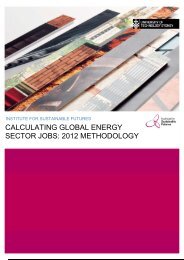download the mexico energy revolution scenario
download the mexico energy revolution scenario
download the mexico energy revolution scenario
Create successful ePaper yourself
Turn your PDF publications into a flip-book with our unique Google optimized e-Paper software.
WORLD ENERGY [R]EVOLUTION<br />
A SUSTAINABLE ENERGY OUTLOOK<br />
9<br />
climate & <strong>energy</strong> policy | TARGETS AND ACTION<br />
3. targets and incentives for renewables<br />
At a time when governments around <strong>the</strong> world are in <strong>the</strong> process of<br />
liberalising <strong>the</strong>ir electricity markets, <strong>the</strong> increasing competitiveness<br />
of renewable <strong>energy</strong> should lead to higher demand. Without<br />
political support, however, renewable <strong>energy</strong> remains at a<br />
disadvantage, marginalised by distortions in <strong>the</strong> world’s electricity<br />
markets created by decades of massive financial, political and<br />
structural support to conventional technologies. Developing<br />
renewables will <strong>the</strong>refore require strong political and economic<br />
efforts, especially through laws which guarantee stable tariffs over<br />
a period of up to 20 years.<br />
At present new renewable <strong>energy</strong> generators have to compete with<br />
old nuclear and fossil fuelled power stations which produce<br />
electricity at marginal costs because consumers and taxpayers have<br />
already paid <strong>the</strong> interest and depreciation on <strong>the</strong> original<br />
investments. Political action is needed to overcome <strong>the</strong>se distortions<br />
and create a level playing field.<br />
Support mechanisms for different sectors and technologies can vary<br />
according to regional characteristics, priorities or starting points,<br />
but some general principles should apply. These are:<br />
• Long term stability: Policy makers need to make sure that<br />
investors can rely on <strong>the</strong> long-term stability of any support<br />
scheme. It is absolutely crucial to avoid stop-and-go markets by<br />
changing <strong>the</strong> system or <strong>the</strong> level of support frequently.<br />
• Encouraging local and regional benefits and public<br />
acceptance: A support scheme should encourage local/regional<br />
development, employment and income generation. It should also<br />
encourage public acceptance of renewables, including increased<br />
stakeholder involvement.<br />
Incentives can be provided for renewable <strong>energy</strong> through both<br />
targets and price support mechanisms.<br />
Action: Establish legally binding targets for renewable <strong>energy</strong><br />
and combined heat and power generation<br />
An increasing number of countries have established targets for<br />
renewable <strong>energy</strong>, ei<strong>the</strong>r as a general target or broken down by<br />
sector for power, transport and heating. These are ei<strong>the</strong>r expressed<br />
in terms of installed capacity or as a percentage of <strong>energy</strong><br />
consumption. China and <strong>the</strong> European Union have a target for 20%<br />
renewable <strong>energy</strong> by 2020, for example, and New Zealand has a<br />
90% by 2025 target.<br />
Although <strong>the</strong>se targets are not always legally binding, <strong>the</strong>y have<br />
served as an important catalyst for increasing <strong>the</strong> share of<br />
renewable <strong>energy</strong> throughout <strong>the</strong> world. The electricity sector<br />
clearly needs a long term horizon, as investments are often only<br />
paid back after 20 to 40 years. Renewable <strong>energy</strong> targets <strong>the</strong>refore<br />
need to have short, medium and long term stages and must be<br />
legally binding in order to be effective. In order for <strong>the</strong> proportion<br />
of renewable <strong>energy</strong> to increase significantly, targets must also be<br />
set in accordance with <strong>the</strong> potential for each technology (wind,<br />
solar, biomass etc) and taking into account existing and planned<br />
infrastructure. Every government should carry out a detailed<br />
analysis of <strong>the</strong> potential and feasibility of renewable energies in its<br />
own country, and define, based on that analysis, <strong>the</strong> deadline for<br />
reaching, ei<strong>the</strong>r individually or in cooperation with o<strong>the</strong>r countries,<br />
a 100% renewable <strong>energy</strong> supply.<br />
Action: Provide a stable return for investors through price<br />
support mechanisms<br />
Price support mechanisms for renewable <strong>energy</strong> are a practical<br />
means of correcting market failures in <strong>the</strong> electricity sector. Their<br />
aim is to support market penetration of those renewable <strong>energy</strong><br />
technologies, such as wind and solar <strong>the</strong>rmal, that currently suffer<br />
from unfair competition due to direct and indirect support to fossil<br />
fuel use and nuclear <strong>energy</strong>, and to provide incentives for technology<br />
improvements and cost reductions so that technologies such as PV,<br />
wave and tidal can compete with conventional sources in <strong>the</strong> future.<br />
Overall, <strong>the</strong>re are two types of incentive to promote <strong>the</strong> deployment<br />
of renewable <strong>energy</strong>. These are Fixed Price Systems where <strong>the</strong><br />
government dictates <strong>the</strong> electricity price (or premium) paid to <strong>the</strong><br />
producer and lets <strong>the</strong> market determine <strong>the</strong> quantity, and<br />
Renewable Quota Systems (in <strong>the</strong> USA referred to as Renewable<br />
Portfolio Standards) where <strong>the</strong> government dictates <strong>the</strong> quantity of<br />
renewable electricity and leaves it to <strong>the</strong> market to determine <strong>the</strong><br />
price. Both systems create a protected market against a<br />
background of subsidised, depreciated conventional generators<br />
whose external environmental costs are not accounted for. Their aim<br />
is to provide incentives for technology improvements and cost<br />
reductions, leading to cheaper renewables that can compete with<br />
conventional sources in <strong>the</strong> future.<br />
The main difference between quota based and price based systems<br />
is that <strong>the</strong> former aims to introduce competition between electricity<br />
producers. However, competition between technology<br />
manufacturers, which is <strong>the</strong> most crucial factor in bringing down<br />
electricity production costs, is present regardless of whe<strong>the</strong>r<br />
government dictates prices or quantities. Prices paid to wind power<br />
producers are currently higher in many European quota based<br />
systems (UK, Belgium, Italy) than in fixed price or premium<br />
systems (Germany, Spain, Denmark).<br />
The European Commission has concluded that fixed price systems<br />
are to be preferred above quota systems. If implemented well, fixed<br />
price systems are a reliable, bankable support scheme for renewable<br />
<strong>energy</strong> projects, providing long term stability and leading to lower<br />
costs. In order for such systems to achieve <strong>the</strong> best possible results,<br />
however, priority access to <strong>the</strong> grid must be ensured.<br />
fixed price systems<br />
Fixed price systems include investment subsidies, fixed feed-in<br />
tariffs, fixed premium systems and tax credits.<br />
• Investment subsidies are capital payments usually made on <strong>the</strong><br />
basis of <strong>the</strong> rated power (in kW) of <strong>the</strong> generator. It is generally<br />
acknowledged, however, that systems which base <strong>the</strong> amount of<br />
support on generator size ra<strong>the</strong>r than electricity output can lead<br />
to less efficient technology development. There is <strong>the</strong>refore a<br />
global trend away from <strong>the</strong>se payments, although <strong>the</strong>y can be<br />
effective when combined with o<strong>the</strong>r incentives.<br />
• Fixed feed-in tariffs (FITs) widely adopted in Europe, have<br />
proved extremely successful in expanding wind <strong>energy</strong> in<br />
102



![Energy [R]evolution - European Commission](https://img.yumpu.com/49109324/1/184x260/energy-revolution-european-commission.jpg?quality=85)


![5905 gp [eu rev]csfr4.qxd - Energy [R]evolution](https://img.yumpu.com/42305023/1/184x260/5905-gp-eu-revcsfr4qxd-energy-revolution.jpg?quality=85)


![5905 gp [eu rev]csfr4.qxd - Energy [R]evolution](https://img.yumpu.com/28729264/1/184x260/5905-gp-eu-revcsfr4qxd-energy-revolution.jpg?quality=85)